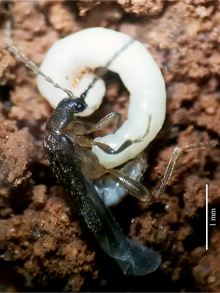Jurasaidae
Family of beetles
| Jurasaidae | |
|---|---|
 | |
| Adult male of Jurasai itajubense mating with a neotenic adult female | |
| Scientific classification | |
| Domain: | Eukaryota |
| Kingdom: | Animalia |
| Phylum: | Arthropoda |
| Class: | Insecta |
| Order: | Coleoptera |
| Suborder: | Polyphaga |
| Infraorder: | Elateriformia |
| Superfamily: | Elateroidea |
| Family: | Jurasaidae Rosa, Costa, Kramp & Kundrata, 2020 |
Jurasaidae is a family of elateroid beetles known from around a half-dozen species in two genera found the Brazilian Atlantic rainforest including drier transitional areas bordering the Caatinga. All known species have neotenic larva-like females and normal males, similar to some other elateroids. They occur in the soil horizon immediately under leaf litter, with the larvae likely being fungivorous, consuming the fluids of fungal hyphae.[1][2][3][4]
Taxonomy
- Genus Jurasai Rosa et al., 2020
- Jurasai digitusdei Rosa et al., 2020
- Jurasai itajubense Rosa et al., 2020
- Jurasai miraculum Biffi et al., 2021
- Jurasai parahybanum Nunes et al., 2023
- Jurasai vanini Biffi et al., 2021
- Jurasai ypauoca Roza, 2021
- Genus Tujamita Rosa et al.., 2020
- Tujamita plenalatum Rosa et al., 2020
References
- ^ Rosa, S.P., Costa, C., Kramp, K., Kundrata, R. (2020) Hidden diversity in the Brazilian Atlantic rainforest: the discovery of Jurasaidae, a new beetle family (Coleoptera, Elateroidea) with neotenic females. Sci Rep 10, 1544. https://doi.org/10.1038/s41598-020-58416-6.
- ^ Biffi, Gabriel; Rosa, Simone Policena; Kundrata, Robin (2021-05-09). "Hide-and-Seek with Tiny Neotenic Beetles in One of the Hottest Biodiversity Hotspots: Towards an Understanding of the Real Diversity of Jurasaidae (Coleoptera: Elateroidea) in the Brazilian Atlantic Forest". Biology. 10 (5): 420. doi:10.3390/biology10050420. ISSN 2079-7737. PMC 8151716. PMID 34065103.
- ^ Silva Roza, André (2021-09-05). "Jurasai ypauoca sp. nov., the sixth species of Jurasaidae, with a key to species of the genus (Coleoptera: Elateroidea)". Studies on Neotropical Fauna and Environment: 1–6. doi:10.1080/01650521.2021.1968755. ISSN 0165-0521. S2CID 239251062.
- ^ Nunes, J.P., Nascimento, M., Pereira-Colavite, A. (2023) A new species of Jurasai Rosa et al., 2020 and the first record of the family Jurasaidae (Coleoptera: Elateroidea) in the northern Brazilian Atlantic Forest. Zootaxa 5323 (4): 524–534. https://doi.org/10.11646/zootaxa.5323.4.4.
- v
- t
- e
Extant Coleoptera families
- Kingdom: Animalia
- Phylum: Arthropoda
- Class: Insecta
- Subclass: Pterygota
- Infraclass: Neoptera
- Superorder: Holometabola
Suborder Archostemata | |
|---|---|
|
Suborder Adephaga | |||
|---|---|---|---|
| |||
Suborder Myxophaga | |
|---|---|
|
Suborder Polyphaga | |||||||||||||||||||||||||||||||||||||||||||||||||
|---|---|---|---|---|---|---|---|---|---|---|---|---|---|---|---|---|---|---|---|---|---|---|---|---|---|---|---|---|---|---|---|---|---|---|---|---|---|---|---|---|---|---|---|---|---|---|---|---|---|
| |||||||||||||||||||||||||||||||||||||||||||||||||
This Elateroidea-related article is a stub. You can help Wikipedia by expanding it. |
- v
- t
- e









